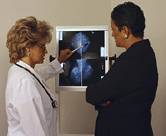
THURSDAY, Dec. 10 (HealthDay News) — Adding chemotherapy to standard cancer-suppressing tamoxifen can boost survival in postmenopausal women with the most common type of breast cancer, known as estrogen receptor-positive, and it’s best given before the tamoxifen regimen starts, according to a new study.
“Chemotherapy with Adriamycin adds to your survival benefit over and above what tamoxifen would do if you are postmenopausal and have positive lymph nodes and estrogen receptor-positive cancer [the most common type],” explained Dr. Kathy Albain, the lead researcher and professor of medicine at Loyola University Chicago Stritch School of Medicine.
And in another study, Albain found that screening breast tumors with an available multi-gene test spots patients who may not need this form of chemotherapy, despite fitting the standard profile.
Both studies are published online Dec. 10, the first in the journal The Lancet and the second in The Lancet Oncology. Albain is also due to present her findings Thursday at the annual San Antonio Breast Cancer Symposium in San Antonio, Texas.
In estrogen receptor-positive cancer, tumor cells carry many receptors on their surfaces to which estrogen can attach, fueling tumor growth. Tamoxifen works by blocking the receptors.
Experts have long debated whether women with estrogen receptor-positive cancers — whose growth is fueled by circulating estrogen — would get more benefit from having a chemotherapy regimen on top of tamoxifen.
Albain led a research team from multiple centers that followed nearly 1,500 breast cancer patients for up to 13 years, with a median (half longer, half less) of nearly nine years. All were past menopause and had hormone receptor-positive cancer that had spread to at least one lymph node in the armpit area.
Albain’s team assigned 381 women to tamoxifen alone, 587 to chemotherapy alone and 590 to both, with some receiving tamoxifen and chemo together and some in a sequential manner.
Tamoxifen was taken daily for five years. The chemo regimen used is called CAF, for “cyclophosphamide, Adriamycin and 5-fluorouracil.”
In all, after accounting for study dropouts, 1,460 women received treatment.
The combined treatments of chemo plus tamoxifen increased the women’s disease-free survival by 24 percent, Albain found. When her team looked at which delivery protocol worked best — simultaneous tamoxifen and chemotherapy or chemo followed by tamoxifen — the sequential approach was found to be better, giving slightly better disease-free survival.
Ten-year disease-free survival estimates were 57 percent for the combination group and 48 percent for the tamoxifen-only group, the researchers found.
However, women receiving chemo were more likely to have drops in white blood cells, important for fighting infections, the team noted. And they were also more prone to blood clots, congestive heart failure and other complications.
In a second study, Albain’s team analyzed whether a gene test, called Oncotype DX, could predict which women would benefit from chemotherapy. Genomic Health, which makes the test, helped fund the study, along with the U.S. National Cancer Institute.
The test, which Albain said is already widely used, is done on the tumor itself. “This puts 21 genes together and comes up with a score,” she said. The score — low, intermediate, high — predicts the risk of recurrence over 10 years if a woman used tamoxifen alone.
When the researchers performed the test on 367 specimens, they found a low score identified those women who may not need the chemo, despite the fact that they have cancer that spread to lymph nodes.
“This is a positive study, there’s no question,” said Dr. Joanne Mortimer, vice chair of medical oncology for the City of Hope Cancer Center in Duarte, Calif., of the first study. “This study tells us [that] if you have positive lymph nodes [and are postmenopausal with estrogen receptor-positive cancer], you should have both chemo and tamoxifen, because the survival was better.”
But, she added, “when you give everyone [who has the estrogen receptor-positive, node-positive breast cancer] chemotherapy, probably there are some who don’t need it.”
According to Mortimer, that’s why the gene test looks promising — it may spare some women from having to have chemo while ensuring that those who will benefit from the treatment get it.
More information
To learn more about breast cancer, visit the American Cancer Society.

